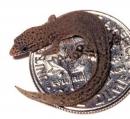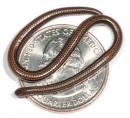Gigants and Dwarfs in the Caribean
Some 65 million years ago, an extraterrestrial object of approximately 6.2 miles of diameter hit the Earth in a place called Chichulub, north of the Yucatan Peninsula.
This occurrence, coupled with other causes, triggered major changes on the planet and prompted the extinction of a large chunk of its wildlife, including the dinosaurs. According to paleontologists, at that moment and pretty close to the collision area, a group of small volcanic islets that used to sink and emerge indistinctively from the sea bottom were drifting eastwardly to form —some 15 million years later during the Eocene Age— a new archipelago: the Antilles. These territories were whipped into their final shape 7,000 years ago.
The archipelago of the Antilles is the largest in the tropical New World, embracing a total surface of 585,639 square miles, trapped halfway in North America, Central America and South America, right at the entrance of the Gulf of Mexico and bathed by the Caribbean Sea. This region comprises a multitude of islands, islets and keys that add up 4,000 in all.
There are the Greater Antilles (Cuba, La Hispaniola, Jamaica and Puerto Rico), and the Lesser Antilles, featuring the Leeward Islands to the north and the Windward Islands to the south, plus the Bahamas and a number of satellite islands off the coasts of South America. In all, they feature an assortment of ecosystems —some of them very fragile— a condition that has made scholars consider the Antilles one of the planet’s “biodiversity hottest spots” in terms of both the danger to its flora and fauna, and the importance of this wildlife.
Delving into how these islands got populated has been one of the greatest biological and geographical puzzles of all, a brain-racking effort if we consider its complex geology and the many origins of its different territories. Many scientists, though, seem to agree that the wildlife of the Antilles stems —through different ways and times— from elements that hailed from the neighboring continental lands.
This has prompted some to believe, based on their oceanic character, that the islands were not connected to the mainland by means of some kind of terrestrial bridge, therefore those wildlife species were bound to cross the sea to get to the islands. However, others claim that at least, approximately 38 millions ago and during a couple of million years, there was a series of semi-soaked lowlands called Garland that for some time hooked up the current lands of South America with La Hispaniola and eastern Cuba. Therefore, transit from the mainland was probably easier than crossing the sea, at least during that period of time.
This complex archipelago is blessed with plenty of virtues that tell it apart from other parts of the planet: gorgeous beaches and scenery, a relatively benign climate —except for the hurricanes and tropical cyclones during a few months of the year— and a very peculiar and highly endemic wildlife that’s the result of the isolation these territories endured. And this fauna is marked by giants and dwarfs, so to speak.
The Giants…
Most of the giants that lived in the Antilles were killed off approximately 10,000 years ago, fundamentally as a result of climate changes and sea level fluctuations. This group was made up of mammals like sloth —some of them as big as today’s black bears. Others were the Megalocnus rodens from Cuba (its South American cousins are now much smaller), and a group of gigantic birds that used to prey on these mammals.
Among these birds were owls and giant spotted owls, like the Ornimegalonix oteroi from Cuba, a humongous non-flying owl like no other on the face of the earth; an eagle and a huge condor with a span as large as 10 feet from wingtips, quite similar to today’s South American condors. There are two good cases in point in the living fauna of the Antilles. Among the insectivores there are small-size animals —as small as a mouse— like the nightly and hard-to-spot shrews.
There are two shrew species in the Antilles —one in Cuba and the other one in La Hispaniola— that can be construed as legit giants when stacked up against their relatives in other parts of the world. Both belong to the Solenodontidae family, hailing exclusively from these two islands. They are by and large the two largest living mammals of the Antilles, two relics of ancient times.
Both species are seriously endangered due to the slashing of their habitats and the introduction of exotic animals in their surroundings. In the case of reptiles, a group of lizards tagged as Anolis with a large number of species in the Americas is commonly found in gardens and near woody formations of all kind. Their size sways between 1.5 and 7 inches long from snout to tail.
However, in both Cuba and La Hispaniola there are several species of these lizards that could reach as many as 20 inches long, a condition that makes them true giants of their kind. These usual treedwellers hunt in the shrubs and in the case of Cuba they are known as chipojos, featuring greenish and bluish shades on their skin. Make no mistakes about it; these critters really strike people’s attention for their looks and beauty.
The Dwarfs…
These are the commonest and comprise several faunal groups, from invertebrates to vertebrates. The Antilles hold several world records when it comes to small-size creatures.
Sticking to the reptiles, the tetrapode —the world’s tiniest crawlerlives exclusively on the islet of Beata, off the coasts of La Hispaniola and just a few miles from the southwestern shore of the Dominican Republic.
This critter that belongs to the gecko family and whose scientific name is Sphaerodactylus ariasae, can be as long as 6.2 inches and dwells under the rocks. In the snake realm, we find just another incredible register. In Barbados, in the Lesser Antilles, sages have unearthed the world’s smallest ophidian: the Leptotyphlos carla, of barely 4 inches long and as wide as a spaghetti strand. It also lives under the rocks and among fallen leaves in faraway spots of this small island, the easternmost of the West Indies.
One of the smallest amphibians is the Iberia little frog (Eleutherodactylus iberia), a species hailing exclusively from some of the mountainous areas of eastern Cuba which is only 0.3 inches long and whose skin coloration gives it a perfect disguise under the rocks and fallen leaves. When it comes to birds, Cuba hosts the smallest of all: the hummingbird or fly bird (Mellisuga helenae). This miniature bird is roughly 3 inches long among males and sports gaudy colors, a powerful chirp and well-rooted territorial habits.
The tiny hummingbird is just another endangered species, though it’s still quite abundant in some parts of the island nation. Mammals of the Antilles also have a small representative in the butterfly bat (Natalus lepidus), which is only 7 inches from wingtips and weighs just a couple of grams. It’s a skillful bug hunter in flight and a dweller of caves in both Cuba and the Bahamas.
In the case of arthropods, the Antilles is credited with a few more world records. The small Holguin scorpion from Cuba (Microtytius fundorai), lives under the rocks and is an active predator of small insects and other invertebrates. These small scorpions are somewhere between 0.3 and 0.7 inches long among males, no doubt one of the smallest in size on the face of the Earth.
The mygalomorphous spider, belonging to the Masteria genre —the same of the great tarantulas— is among the tiniest of all. It’s so small in size (the male of some species reaches just 0.1 inches long) and so translucent its colors that adults look like the offspring of other bigger tarantulas.
These teenyweenie spiders can be spotted on some islands of the Antilles, like St. Vincent, Puerto Rico, Jamaica and Cuba, always bundled up under fallen leaves. In addition, mavens dug out a fossil species embedded in a piece of solidified amber in the Dominican Republic that’s 15 million years old.
Daytime butterflies are insects that embellish the fields with their striking colors and that have captured the attention of naturalists for centuries. In the Antilles, we find the world’s smallest daytime butterfly of all, belonging to the Lycaenidae family, with hues that are indigo and bluish. The Small Blue (Brephridium exilis), whose males have a wingtip span of just 3.1 to 3.5 inches long, are labeled among the smallest in the globe and they can be seen in the coastal areas of Cuba and La Hispaniola.
A plausible theory… An explanation for this phenomenon lies precisely in the characteristics of the local wildlife of these islands and archipelagos, an object of study for the founding fathers of the Natural Selection theory, (the chief mechanism of the evolution), Darwin and Wallace back in the 19th century, plus many other researchers of the 20th century.
On the islands and in the archipelagos, the evolutionary process is either simplified or overblown as compared to the mainland, especially as a result of the attributes of species that live there and the features of the colonies they form.
The different insular species share a number of characteristics, including the ability to scatter territorially, to change their size, their endemism, their relict character, the loss of defensive attributes, their adaptive radiation and the diminishing of their genetic features. On the other hand, the colonies these species form are marked by imbalance and impoverishment when compared to other areas within the same region and the characteristics of the continental lands.
But, how can all this explain size changes in groups that are so uneven? Some think of a combination of factors closely linked to competition for resources and predation as the main reason behind all this. This situation fosters fluctuations in the distribution line of available energy for the different species. Species armed with the ability to defend their territories —they are called the K strategists— benefit from the reduction of such relative factors as predation and competition if their size accrues because they can fill up on more energy.
This stops being a drawback for evolutionary success because there are no enemies out there that can eat them alive. Nonetheless, in the case of those species stripped of the ability to defend their territories (the so-called R strategists), their dwindling size is a warranty of finding more resources that could clinch their survival because they need less food and their small size becomes a benefit for they can go unnoticed in the face of their foes.
There’s no doubt that islands and archipelagos are genuine laboratories of evolution, while the peculiarities of the Antilles’ wildlife lay bare processes and relationships that remain far from being fully understood and require more research and studies. It’s necessary for us not only to admire their beauty and singularities, but also to comprehend the urgent need of protecting them at any rate.





























































































































